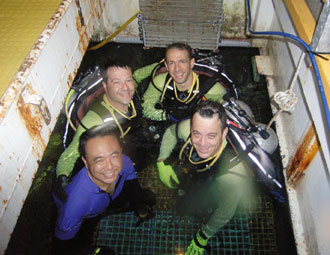|
IMR Vessel
An Inspection, Maintenance and Repair (IMR) vessel is a highly technical vessel, deployed in the offshore industry. Their primary task comprises the inspection and repair of subsea facilities and installations. These vessels are often equipped for other tasks including diving support, scale treatment and light construction work. Capabilities IMR vessels are designed to continue operations in harsh weather conditions. They are equipped with IMO Class II or Class III Dynamic Positioning Systems and have the latest technology on board. The vessels usually have a large deck area, used for the carriage of auxiliary equipment, spools, containers, etc. The accommodation provides capacity for between 80 and 100 people. The vessels often have a helicopter platform. Most vessels have 1 or 2 cranes for supplies and installation of small-size structures. All vessels have a moon pool installed for the support of ROVs. Many IMR vessels have tanks for the supply of potable fresh water, brine and ... [...More Info...] [...Related Items...] OR: [Wikipedia] [Google] [Baidu] |
Dynamic Positioning
Dynamic positioning (DP) is a computer-controlled system to automatically maintain a vessel's position and heading by using its own propellers and thrusters. Position reference sensors, combined with wind sensors, motion sensors and gyrocompasses, provide information to the computer pertaining to the vessel's position and the magnitude and direction of environmental forces affecting its position. Examples of vessel types that employ DP include ships and semi-submersible mobile offshore drilling units (MODU), oceanographic research vessels, cable layer ships and cruise ships. The computer program contains a mathematical model of the vessel that includes information pertaining to the wind and current drag of the vessel and the location of the thrusters. This knowledge, combined with the sensor information, allows the computer to calculate the required steering angle and thruster output for each thruster. This allows operations at sea where mooring or anchoring is not feasible ... [...More Info...] [...Related Items...] OR: [Wikipedia] [Google] [Baidu] |
Moon Pool
A moon pool is a feature of marine drilling platforms, drillships and diving support vessels, some marine research and underwater exploration or research vessels, and underwater habitats, in which it is also known as a wet porch. It is an opening in the floor or base of the hull, platform, or chamber giving access to the water below, allowing technicians or researchers to lower tools and instruments into the sea. It provides shelter and protection so that even if the ship is in high seas or surrounded by ice, researchers can work in comfort rather than on a deck exposed to the elements. A moon pool also allows divers, diving bells, ROVs, or small submersible craft to enter or leave the water easily and in a more protected environment. Moon pools can be used in chambers below sea level, especially for the use of scuba divers, and their design requires more complex consideration of air and water pressure acting on the moon pool surface. First use in oil drilling at sea Moon po ... [...More Info...] [...Related Items...] OR: [Wikipedia] [Google] [Baidu] |
Remotely Operated Underwater Vehicle
A remotely operated underwater vehicle (technically ROUV or just ROV) is a tethered underwater mobile device, commonly called ''underwater robot''. Definition This meaning is different from remote control vehicles operating on land or in the air. ROVs are unoccupied, usually highly maneuverable, and operated by a crew either aboard a vessel/floating platform or on proximate land. They are common in deepwater industries such as offshore hydrocarbon extraction. They are linked to a host ship by a neutrally buoyant tether or, often when working in rough conditions or in deeper water, a load-carrying umbilical cable is used along with a tether management system (TMS). The TMS is either a garage-like device which contains the ROV during lowering through the splash zone or, on larger work-class ROVs, a separate assembly which sits on top of the ROV. The purpose of the TMS is to lengthen and shorten the tether so the effect of cable drag where there are underwater currents is minim ... [...More Info...] [...Related Items...] OR: [Wikipedia] [Google] [Baidu] |
Greywater
Greywater (or grey water, sullage, also spelled gray water in the United States) refers to domestic wastewater generated in households or office buildings from streams without fecal contamination, i.e., all streams except for the wastewater from toilets. Sources of greywater include sinks, showers, baths, washing machines or dishwashers. As greywater contains fewer pathogens than blackwater, it is generally safer to handle and easier to treat and reuse onsite for toilet flushing, landscape or crop irrigation, and other non- potable uses. Greywater may still have some pathogen content from laundering soiled clothing or cleaning the anal area in the shower or bath. The application of greywater reuse in urban water systems provides substantial benefits for both the water supply subsystem, by reducing the demand for fresh clean water, and the wastewater subsystems by reducing the amount of conveyed and treated wastewater. Treated greywater has many uses, such as toilet flush ... [...More Info...] [...Related Items...] OR: [Wikipedia] [Google] [Baidu] |
Sewage
Sewage (or domestic sewage, domestic wastewater, municipal wastewater) is a type of wastewater that is produced by a community of people. It is typically transported through a sewer system. Sewage consists of wastewater discharged from residences and from commercial, institutional and public facilities that exist in the locality. Sub-types of sewage are greywater (from sinks, bathtubs, showers, dishwashers, and clothes washers) and blackwater (the water used to flush toilets, combined with the human waste that it flushes away). Sewage also contains soaps and detergents. Food waste may be present from dishwashing, and food quantities may be increased where garbage disposal units are used. In regions where toilet paper is used rather than bidets, that paper is also added to the sewage. Sewage contains macro-pollutants and micro-pollutants, and may also incorporate some municipal solid waste and pollutants from industrial wastewater. Sewage usually travels from a building's p ... [...More Info...] [...Related Items...] OR: [Wikipedia] [Google] [Baidu] |



.jpg)